Runoff Characteristics and Soil Loss Mechanism in the Weathered Granite Area under Simulated Rainfall
Abstract
:1. Introduction
2. Materials and Methods
2.1. Experimental Equipment
2.2. Materials
2.3. Experimental Design and Measurements
2.4. Data Calculation and Analysis
3. Results and Discussion
3.1. Characteristics of Runoff Generation
3.2. Characteristics of Sediment Yield
3.3. Characteristics of Sediment Size
4. Conclusions
Author Contributions
Funding
Institutional Review Board Statement
Informed Consent Statement
Conflicts of Interest
References
- Kiani-Harchegani, M.; Sadeghi, S.H.; Asadi, H. Comparing grain size distribution of sediment and original soil under raindrop detachment and raindrop-induced and flow transport mechanism. Hydrol. Sci. J. 2018, 63, 312–323. [Google Scholar] [CrossRef]
- Zhang, J.; Wang, Z. Interrill soil erosion processes on steep slopes. J. Hydrol. 2017, 548, 652–664. [Google Scholar] [CrossRef]
- Deng, Y.; Duan, X.; Ding, S.; Cai, C.; Chen, J. Suction stress characteristics in granite red soils and their relationship with the collapsing gully in south China. Catena 2018, 171, 505–522. [Google Scholar] [CrossRef]
- Fei, K.; Deng, L.; Zhang, L.; Sun, T.; Wu, Y.; Fan, X.; Dong, Y. Lateral transport of soil total carbon with slope runoff and interflow: Effects of rainstorm characteristics under simulated rainfall. Catena 2019, 179, 39–48. [Google Scholar] [CrossRef]
- Vaezi, A.R.; Ahmadi, M.; Cerdà, A. Contribution of raindrop impact to the change of soil physical properties and water erosion under semi-arid rainfalls. Sci. Total Environ. 2017, 583, 382–392. [Google Scholar] [CrossRef] [PubMed]
- Zhang, P.; Yao, W.; Liu, G.; Xiao, P.; Sun, W. Experimental study of sediment transport processes and size selectivity of eroded sediment on steep Pisha sandstone slopes. Geomorphology 2020, 363, 107211. [Google Scholar] [CrossRef]
- Liu, D.; She, D.; Yu, S.; Shao, G.; Chen, D. Rainfall intensity and slope gradient effects on sediment losses and splash from a saline–sodic soil under coastal reclamation. Catena 2015, 128, 54–62. [Google Scholar] [CrossRef]
- Ebabu, K.; Tsunekawa, A.; Haregeweyn, N.; Adgo, E.; Meshesha, D.T.; Aklog, D.; Masunaga, T.; Tsubo, M.; Sultan, D.; Fenta, A.A.; et al. Effects of land use and sustainable land management practices on runoff and soil loss in the Upper Blue Nile basin, Ethiopia. Sci. Total Environ. 2019, 648, 1462–1475. [Google Scholar] [CrossRef] [PubMed]
- Shi, Z.; Fang, N.; Wu, F.; Wang, L.; Yue, B.; Wu, G. Soil erosion processes and sediment sorting associated with transport mechanisms on steep slopes. J. Hydrol. 2012, 454–455, 123–130. [Google Scholar] [CrossRef]
- Wu, X.; Wei, Y.; Wang, J.; Xia, J.; Cai, C.; Wu, L.; Fu, Z.; Wei, Z. Effects of erosion degree and rainfall intensity on erosion processes for Ultisols derived from quaternary red clay. Agric. Ecosyst. Environ. 2017, 249, 226–236. [Google Scholar] [CrossRef]
- Uusitalo, R. Suspended soil as a source of potentially bioavailable phosphorus in surface runoff waters from clay soils. Water Res. 2000, 34, 2477–2482. [Google Scholar] [CrossRef]
- Haygarth, P.; Jarvis, S. Soil derived phosphorus in surface runoff from grazed grassland lysimeters. Water Res. 1997, 31, 140–148. [Google Scholar] [CrossRef]
- Aksoy, H.; Eris, E.; Tayfur, G. Empirical Sediment Transport Models Based on Indoor Rainfall Simulator and Erosion Flume Experimental Data. Land Degrad. Dev. 2017, 28, 1320–1328. [Google Scholar] [CrossRef]
- Qi, Y.; Zhang, T.C. Transport of manure-borne testosterone in soils affected by artificial rainfall events. Water Res. 2016, 93, 265–275. [Google Scholar] [CrossRef] [PubMed] [Green Version]
- Hall, K.K.; Evanshen, B.G.; Maier, K.J.; Scheuerman, P.R. Application of Multivariate Statistical Methodology to Model Factors Influencing Fate and Transport of Fecal Pollution in Surface Waters. J. Environ. Qual. 2014, 43, 358–370. [Google Scholar] [CrossRef] [PubMed]
- Napoli, M.; Marta, A.D.; Zanchi, C.A.; Orlandini, S. Assessment of soil and nutrient losses by runoff under different soil management practices in an Italian hilly vineyard. Soil Tillage Res. 2017, 168, 71–80. [Google Scholar] [CrossRef]
- Gupta, S.K.; Tyagi, J.; Sharma, G.; Jethoo, A.S.; Singh, P.K. An Event-Based Sediment Yield and Runoff Modeling Using Soil Moisture Balance/Budgeting (SMB) Method. Water Resour. Manag. 2019, 33, 3721–3741. [Google Scholar] [CrossRef]
- Fu, X.T.; Zhang, L.P.; Wang, Y. Effect of Slope Length and Rainfall Intensity on Runoff and Erosion Conversion from Laboratory to Field. Water Resour. 2019, 46, 530–541. [Google Scholar] [CrossRef]
- Hao, H.-X.; Wang, J.-G.; Guo, Z.-L.; Hua, L. Water erosion processes and dynamic changes of sediment size distribution under the combined effects of rainfall and overland flow. Catena 2019, 173, 494–504. [Google Scholar] [CrossRef]
- An, J.; Zhang, Y.; Wang, Y. Rainstorm pattern effects on the size distribution of soil aggregate in eroded sediment within contour ridge systems. J. Soils Sediments 2020, 20, 2192–2206. [Google Scholar] [CrossRef]
- Sabzevari, T.; Talebi, A. Effect of hillslope topography on soil erosion and sediment yield using USLE model. Acta Geophys. 2019, 67, 1587–1597. [Google Scholar] [CrossRef]
- Zambon, N.; Johannsen, L.L.; Strauss, P.; Dostal, T.; Zumr, D.; Cochrane, T.A.; Klik, A. Splash erosion affected by initial soil moisture and surface conditions under simulated rainfall. Catena 2021, 196, 104827. [Google Scholar] [CrossRef]
- Saedi, T.; Shorafa, M.; Gorji, M.; Moghadam, B.K. Indirect and direct effects of soil properties on soil splash erosion rate in calcareous soils of the central Zagross, Iran: A laboratory study. Geoderma 2016, 271, 1–9. [Google Scholar] [CrossRef]
- Koiter, A.J.; Owens, P.N.; Petticrew, E.L.; Lobb, D. The role of soil surface properties on the particle size and carbon selectivity of interrill erosion in agricultural landscapes. Catena 2017, 153, 194–206. [Google Scholar] [CrossRef]
- Xia, J.; Cai, C.; Wei, Y.; Zhou, Y.; Gu, J.; Xiong, Y.; Zhou, X. Variations of soil hydraulic properties along granitic slopes in Benggang erosion areas. J. Soils Sediments 2021, 21, 1177–1189. [Google Scholar] [CrossRef]
- Martínez-Mena, M.; Carrillo-López, E.; Boix-Fayos, C.; Almagro, M.; Franco, N.G.; Díaz-Pereira, E.; Montoya, I.; de Vente, J. Long-term effectiveness of sustainable land management practices to control runoff, soil erosion, and nutrient loss and the role of rainfall intensity in Mediterranean rainfed agroecosystems. Catena 2020, 187, 104352. [Google Scholar] [CrossRef]
- Chen, H.; Zhang, X.; Abla, M.; Lü, D.; Yan, R.; Ren, Q.; Ren, Z.; Yang, Y.; Zhao, W.; Lin, P.; et al. Effects of vegetation and rainfall types on surface runoff and soil erosion on steep slopes on the Loess Plateau, China. Catena 2018, 170, 141–149. [Google Scholar] [CrossRef]
- Starke, J.; Ehlers, T.A.; Schaller, M. Latitudinal effect of vegetation on erosion rates identified along western South America. Science 2020, 367, 1358–1361. [Google Scholar] [CrossRef] [PubMed]
- Kiani-Harchegani, M.; Sadeghi, S.H.; Singh, V.P.; Asadi, H.; Abedi, M. Effect of rainfall intensity and slope on sediment particle size distribution during erosion using partial eta squared. Catena 2019, 176, 65–72. [Google Scholar] [CrossRef]
- Liang, Z.; Liu, H.; Zhao, Y.; Wang, Q.; Wu, Z.; Deng, L.; Gao, H. Effects of rainfall intensity, slope angle, and vegetation coverage on the erosion characteristics of Pisha sandstone slopes under simulated rainfall conditions. Environ. Sci. Pollut. Res. 2020, 27, 17458–17467. [Google Scholar] [CrossRef]
- Khaledi Darvishan, A.; Homayonfar, V.; Sadeghi, S.H. Designing, construction and calibration of a portable rainfall simulator for field runoff and soil erosion studies. Iran. J. Watershed Manag. Sci. Eng. 2016, 10, 105–112. [Google Scholar]
- Sobol, N.V.; Gabbasova, I.M.; Komissarov, M.A. Effect of rainfall intensity and slope steepness on the development of soil erosion in the Southern Cis-Ural region (A model experiment). Eurasian Soil Sci. 2017, 50, 1098–1104. [Google Scholar] [CrossRef]
- Dai, Q.; Peng, X.; Wang, P.; Li, C.; Shao, H. Surface erosion and underground leakage of yellow soil on slopes in karst regions of southwest China. Land Degrad. Dev. 2018, 29, 2438–2448. [Google Scholar] [CrossRef]
- Guo, Z.; Ma, M.; Cai, C.; Wu, Y. Combined effects of simulated rainfall and overland flow on sediment and solute transport in hillslope erosion. J. Soils Sediments 2018, 18, 1120–1132. [Google Scholar] [CrossRef]
- Zhao, L.; Hou, R. Effects of collection time intervals of surface runoff and sediment on soil erosion analysis during rainfall. Catena 2018, 165, 201–206. [Google Scholar] [CrossRef]
- Xu, J.; Zhang, J.; Li, M.; Wang, F. Effect of Rain Peak Morphology on Runoff and Sediment Yield in Miyun Water Source Reserve in China. Water 2019, 11, 2429. [Google Scholar] [CrossRef] [Green Version]
- Huang, J.; Wu, P.; Zhao, X. Effects of rainfall intensity, underlying surface and slope gradient on soil infiltration under simulated rainfall experiments. Catena 2013, 104, 93–102. [Google Scholar] [CrossRef]
- Borrelli, P.; Robinson, D.A.; Fleischer, L.R.; Lugato, E.; Ballabio, C.; Alewell, C.; Meusburger, K.; Modugno, S.; Schütt, B.; Ferro, V.; et al. An assessment of the global impact of 21st century land use change on soil erosion. Nat. Commun. 2017, 8, 1–13. [Google Scholar] [CrossRef] [Green Version]
- Astorga, R.T.; Villalobos, S.D.L.S.; Velasco, H.; Domínguez-Quintero, O.; Cardoso, R.P.; Dos Anjos, R.M.; Diawara, Y.; Dercon, G.; Mabit, L. Exploring innovative techniques for identifying geochemical elements as fingerprints of sediment sources in an agricultural catchment of Argentina affected by soil erosion. Environ. Sci. Pollut. Res. 2018, 25, 20868–20879. [Google Scholar] [CrossRef]
- Quan, X.; He, J.; Cai, Q.; Sun, L.; Li, X.; Wang, S. Soil erosion and deposition characteristics of slope surfaces for two loess soils using indoor simulated rainfall experiment. Soil Tillage Res. 2020, 204, 104714. [Google Scholar] [CrossRef]
- Wu, L.; Li, P.; Ma, X.-Y. Estimating nonpoint source pollution load using four modified export coefficient models in a large easily eroded watershed of the loess hilly–gully region, China. Environ. Earth Sci. 2016, 75, 1056. [Google Scholar] [CrossRef]
- Zhou, J.; Fu, B.; Gao, G.; Lü, Y.; Liu, Y.; Lü, N.; Wang, S. Effects of precipitation and restoration vegetation on soil erosion in a semi-arid environment in the Loess Plateau, China. Catena 2016, 137, 1–11. [Google Scholar] [CrossRef]
- Chen, J.; Xiao, H.; Li, Z.; Liu, C.; Ning, K.; Tang, C. How effective are soil and water conservation measures (SWCMs) in reducing soil and water losses in the red soil hilly region of China? A meta-analysis of field plot data. Sci. Total Environ. 2020, 735, 139517. [Google Scholar] [CrossRef]
- Zheng, M.-G.; Li, R.-K.; He, J.-J.; Cui, M. Sediment delivery across multiple spatio-temporal scales in an agriculture watershed of the Chinese Loess Plateau. J. Mt. Sci. 2015, 12, 1241–1253. [Google Scholar] [CrossRef]
- Golosov, V.; Collins, A.L.; Tang, Q.; Zhang, X.; Zhou, P.; He, X.; Wen, A. Sediment transfer at different spatial and temporal scales in the Sichuan Hilly Basin, China: Synthesizing data from multiple approaches and preliminary interpretation in the context of climatic and anthropogenic drivers. Sci. Total Environ. 2017, 598, 319–329. [Google Scholar] [CrossRef]
- Ali, M.; Sterk, G.; Seeger, M.; Boersema, M.; Peters, P. Effect of hydraulic parameters on sediment transport capacity in overland flow over erodible beds. Hydrol. Earth Syst. Sci. 2012, 16, 591–601. [Google Scholar] [CrossRef] [Green Version]
- Zhao, Q.; Li, D.; Zhuo, M.; Guo, T.; Liao, Y.; Xie, Z. Effects of rainfall intensity and slope gradient on erosion characteristics of the red soil slope. Stoch. Environ. Res. Risk Assess. 2015, 29, 609–621. [Google Scholar] [CrossRef]
- Guo, T.; Wang, Q.; Li, D.; Zhuang, J.; Wu, L. Flow hydraulic characteristic effect on sediment and solute transport on slope erosion. Catena 2013, 107, 145–153. [Google Scholar] [CrossRef]
- Sajjadi, S.A.; Mahmoodabadi, M. Sediment concentration and hydraulic characteristics of rain-induced overland flows in arid land soils. J. Soils Sediments 2015, 15, 710–721. [Google Scholar] [CrossRef]
- Xing, H.; Huang, Y.-H.; Chen, X.-Y.; Luo, B.-L.; Mi, H.-X. Comparative study of soil erodibility and critical shear stress between loess and purple soils. J. Hydrol. 2018, 558, 625–631. [Google Scholar] [CrossRef]
- Deng, L.-Z.; Fei, K.; Sun, T.-Y.; Zhang, L.-P.; Fan, X.-J.; Ni, L. Characteristics of runoff processes and nitrogen loss via surface flow and interflow from weathered granite slopes of Southeast China. J. Mt. Sci. 2019, 16, 1048–1064. [Google Scholar] [CrossRef]
- Anache, J.A.; Flanagan, D.C.; Srivastava, A.; Wendland, E.C. Land use and climate change impacts on runoff and soil erosion at the hillslope scale in the Brazilian Cerrado. Sci. Total Environ. 2018, 622–623, 140–151. [Google Scholar] [CrossRef]
- Deng, L.; Sun, T.; Fei, K.; Zhang, L.; Fan, X.; Wu, Y.; Ni, L. Effects of erosion degree, rainfall intensity and slope gradient on runoff and sediment yield for the bare soils from the weathered granite slopes of SE China. Geomorphology 2020, 352, 106997. [Google Scholar] [CrossRef]
- Sun, T.; Deng, L.; Fei, K.; Zhang, L.; Fan, X. Characteristics of phosphorus adsorption and desorption in erosive weathered granite area and effects of soil properties. Environ. Sci. Pollut. Res. 2020, 27, 28780–28793. [Google Scholar] [CrossRef] [PubMed]
- Ran, Q.; Su, D.; Li, P.; He, Z. Experimental study of the impact of rainfall characteristics on runoff generation and soil erosion. J. Hydrol. 2012, 424–425, 99–111. [Google Scholar] [CrossRef]
- Katebikord, A.; Darvishan, A.K.; Alavi, S.J.; Student, G.M.; Professor, A. Effects of Rainfall Duration on Hydrological Response of Field Plots under Rainfall Simulation. J. Watershed Manag. Res. 2018, 9, 49–56. [Google Scholar] [CrossRef]
- Vaezi, A.R.; Bahrami, H.A. Relationship between Soil Productivity and Erodibility in Rainfed Wheat Lands in Northwestern Iran. J. Agric. Sci. Technol. 2014, 16, 1455–1466. [Google Scholar]
- Asadi, H.; Moussavi, A.; Ghadiri, H.; Rose, C. Flow-driven soil erosion processes and the size selectivity of sediment. J. Hydrol. 2011, 406, 73–81. [Google Scholar] [CrossRef] [Green Version]
- Mahmoodabadi, M.; Sajjadi, S.A. Effects of rain intensity, slope gradient and particle size distribution on the relative contributions of splash and wash loads to rain-induced erosion. Geomorphology 2016, 253, 159–167. [Google Scholar] [CrossRef]
- Han, Y.; Fan, Y.; Xin, Z.; Wang, L.; Cai, Q.; Wang, X. Effects of wetting rate and simulated rain duration on soil crust formation of red loam. Environ. Earth Sci. 2016, 75, 1–9. [Google Scholar] [CrossRef]
- Lu, J.; Zheng, F.; Li, G.; Bian, F.; An, J. The effects of raindrop impact and runoff detachment on hillslope soil erosion and soil aggregate loss in the Mollisol region of Northeast China. Soil Tillage Res. 2016, 161, 79–85. [Google Scholar] [CrossRef]
- Nciizah, A.; Wakindiki, I. Rainfall pattern effects on crusting, infiltration and erodibility in some South African soils with various texture and mineralogy. Water SA 2014, 40, 57. [Google Scholar] [CrossRef] [Green Version]
- Morin, J.; Van Winkel, J. The Effect of Raindrop Impact and Sheet Erosion on Infiltration Rate and Crust Formation. Soil Sci. Soc. Am. J. 1996, 60, 1223–1227. [Google Scholar] [CrossRef]
- Comino, J.R.; Sinoga, J.R.; González, J.S.; Guerra-Merchán, A.; Seeger, M.; Ries, J. High variability of soil erosion and hydrological processes in Mediterranean hillslope vineyards (Montes de Málaga, Spain). Catena 2016, 145, 274–284. [Google Scholar] [CrossRef]
- An, J.; Zheng, F.; Lu, J.; Li, G. Investigating the Role of Raindrop Impact on Hydrodynamic Mechanism of Soil Erosion Under Simulated Rainfall Conditions. Soil Sci. 2012, 177, 517–526. [Google Scholar] [CrossRef]
- Beuselinck, L.; Govers, G.; Hairsine, P.; Sander, G.; Breynaert, M. The influence of rainfall on sediment transport by overland flow over areas of net deposition. J. Hydrol. 2002, 257, 145–163. [Google Scholar] [CrossRef]
- An, J.; Liu, Q. Soil aggregate breakdown in response to wetting rate during the inter-rill and rill stages of erosion in a contour ridge system. Catena 2017, 157, 241–249. [Google Scholar] [CrossRef]
- Strohmeier, S.; Laaha, G.; Holzmann, H.; Klik, A. Magnitude and Occurrence Probability of Soil Loss: A Risk Analytical Approach for the Plot Scale For Two Sites in Lower Austria. Land Degrad. Dev. 2016, 27, 43–51. [Google Scholar] [CrossRef]
- Kinnell, P. The influence of time and other factors on soil loss produced by rain-impacted flow under artificial rainfall. J. Hydrol. 2020, 587, 125004. [Google Scholar] [CrossRef]
- Ma, R.; Li, Z.-X.; Cai, C.-F.; Wang, J.-G. The dynamic response of splash erosion to aggregate mechanical breakdown through rainfall simulation events in Ultisols (subtropical China). Catena 2014, 121, 279–287. [Google Scholar] [CrossRef]
- Shi, Z.-H.; Yan, F.-L.; Li, L.; Li, Z.-X.; Cai, C.-F. Interrill erosion from disturbed and undisturbed samples in relation to topsoil aggregate stability in red soils from subtropical China. Catena 2010, 81, 240–248. [Google Scholar] [CrossRef]
- Tuset, J.; Vericat, D.; Batalla, R. Rainfall, runoff and sediment transport in a Mediterranean mountainous catchment. Sci. Total Environ. 2016, 540, 114–132. [Google Scholar] [CrossRef]
- Tian, P.; Xu, X.; Pan, C.; Hsu, K.; Yang, T. Impacts of rainfall and inflow on rill formation and erosion processes on steep hillslopes. J. Hydrol. 2017, 548, 24–39. [Google Scholar] [CrossRef]
- Wu, X.; Wei, Y.; Wang, J.; Cai, C.; Deng, Y.; Xia, J. RUSLE erodibility of heavy-textured soils as affected by soil type, erosional degradation, and rainfall intensity: A field simulation. Land Degrad. Dev. 2018, 29, 408–421. [Google Scholar] [CrossRef]
- Lin, J.; Huang, Y.; Zhao, G.; Jiang, F.; Wang, M.-K.; Ge, H. Flow-driven soil erosion processes and the size selectivity of eroded sediment on steep slopes using colluvial deposits in a permanent gully. Catena 2017, 157, 47–57. [Google Scholar] [CrossRef]
- Sadeghi, S.H.; Harchegani, M.K.; Asadi, H. Variability of particle size distributions of upward/downward splashed materials in different rainfall intensities and slopes. Geoderma 2017, 290, 100–106. [Google Scholar] [CrossRef]
- Loch, R.; Donnollan, T. Field rainfall simulator studies on two clay soils of the Darling Downs, Queensland. II. Aggregate Breakdpwn, sediment properties and soil erodibility. Soil Res. 1983, 21, 47–58. [Google Scholar] [CrossRef]
- Leguédois, S.; Planchon, O.; Legout, C.; Le Bissonnais, Y. Splash Projection Distance for Aggregated Soils. Soil Sci. Soc. Am. J. 2005, 69, 30–37. [Google Scholar] [CrossRef]
- Wang, L.; Shi, Z. Size Selectivity of Eroded Sediment Associated with Soil Texture on Steep Slopes. Soil Sci. Soc. Am. J. 2015, 79, 917–929. [Google Scholar] [CrossRef]

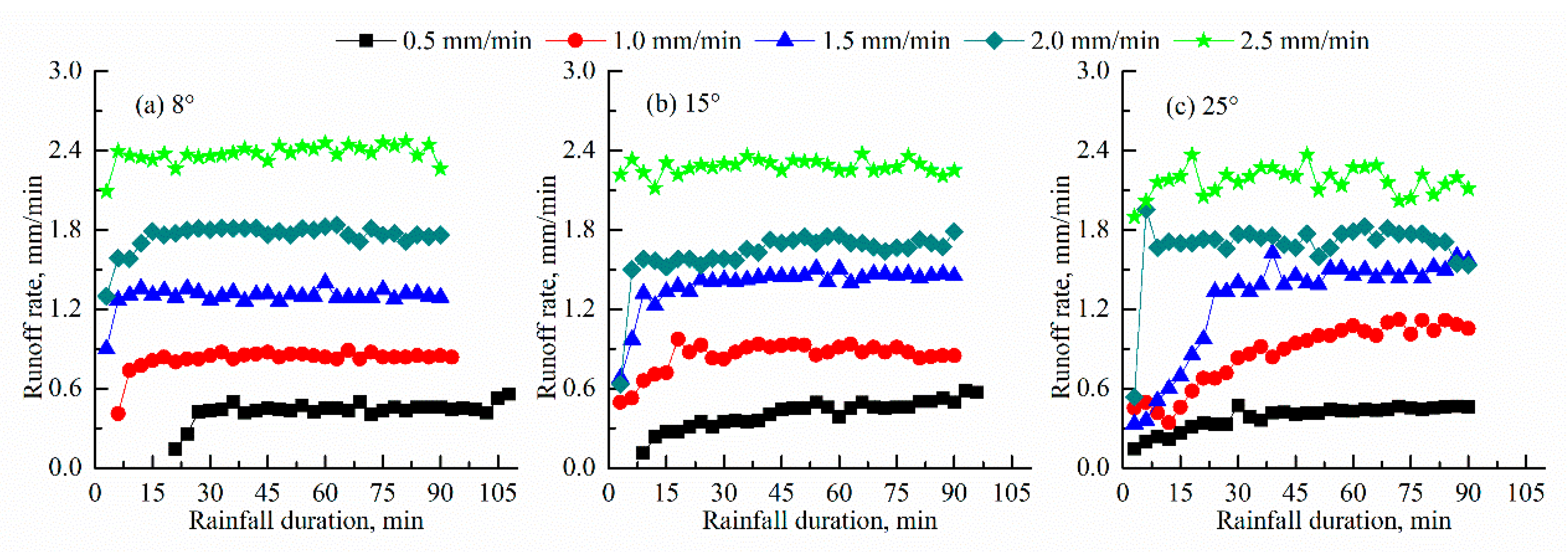
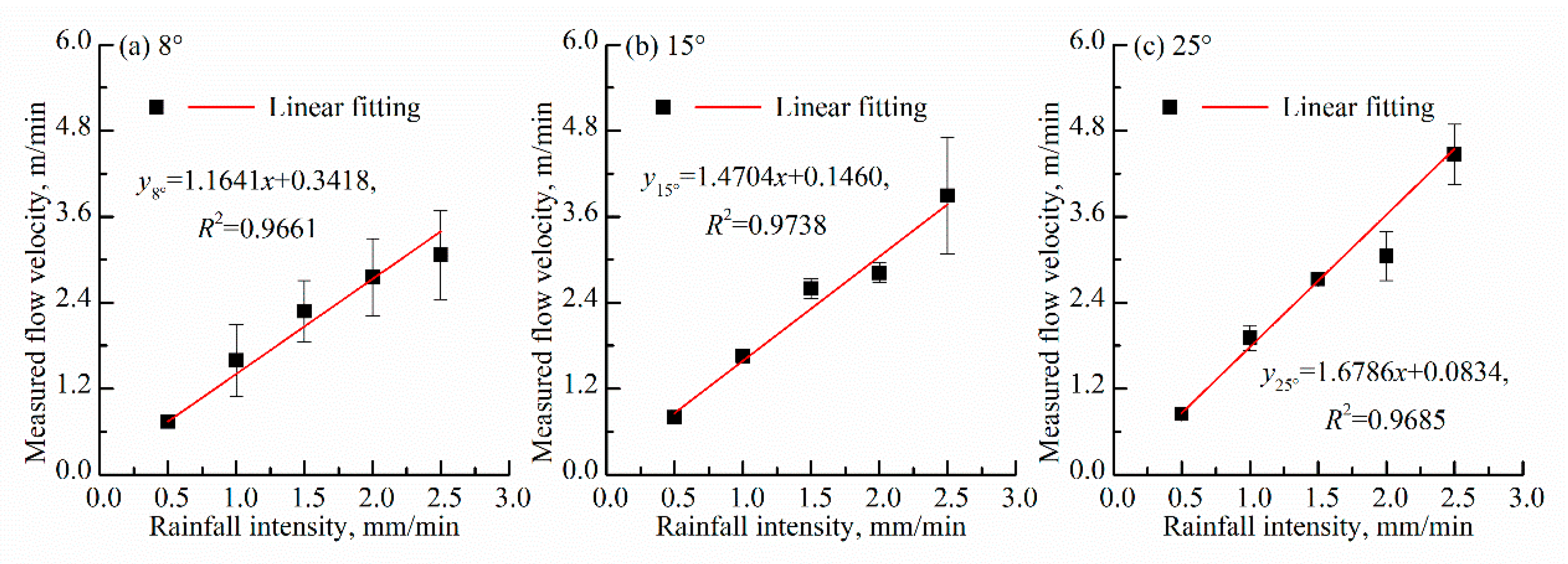
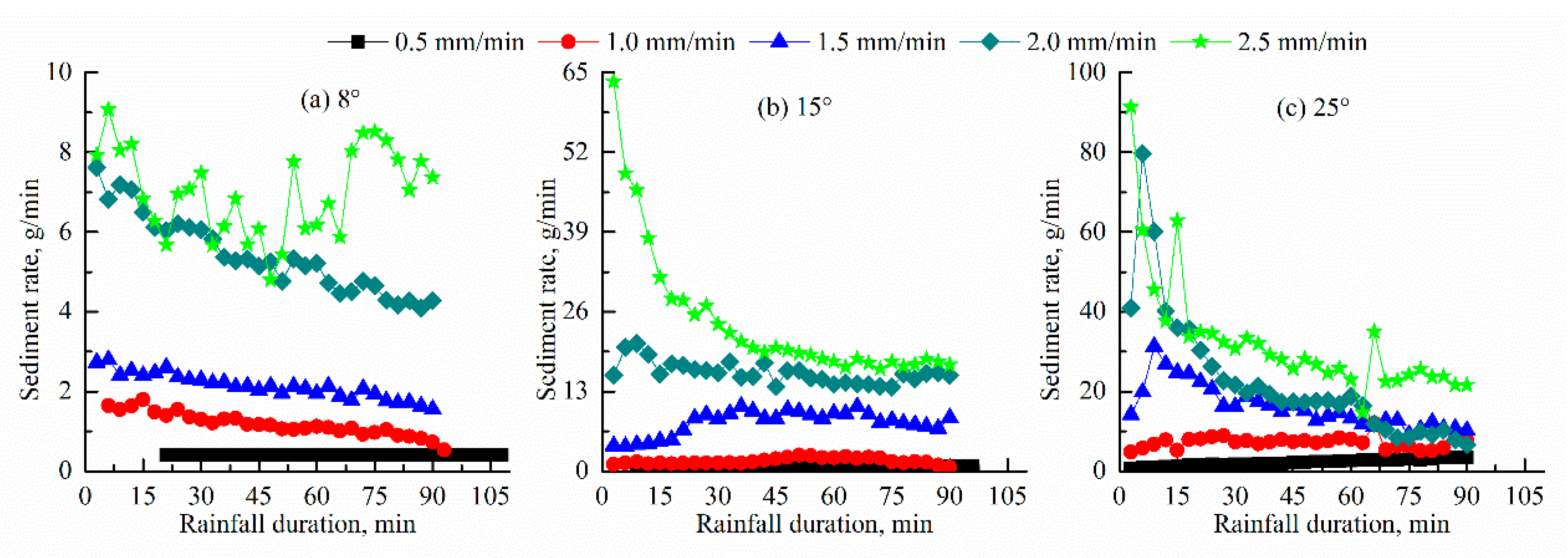
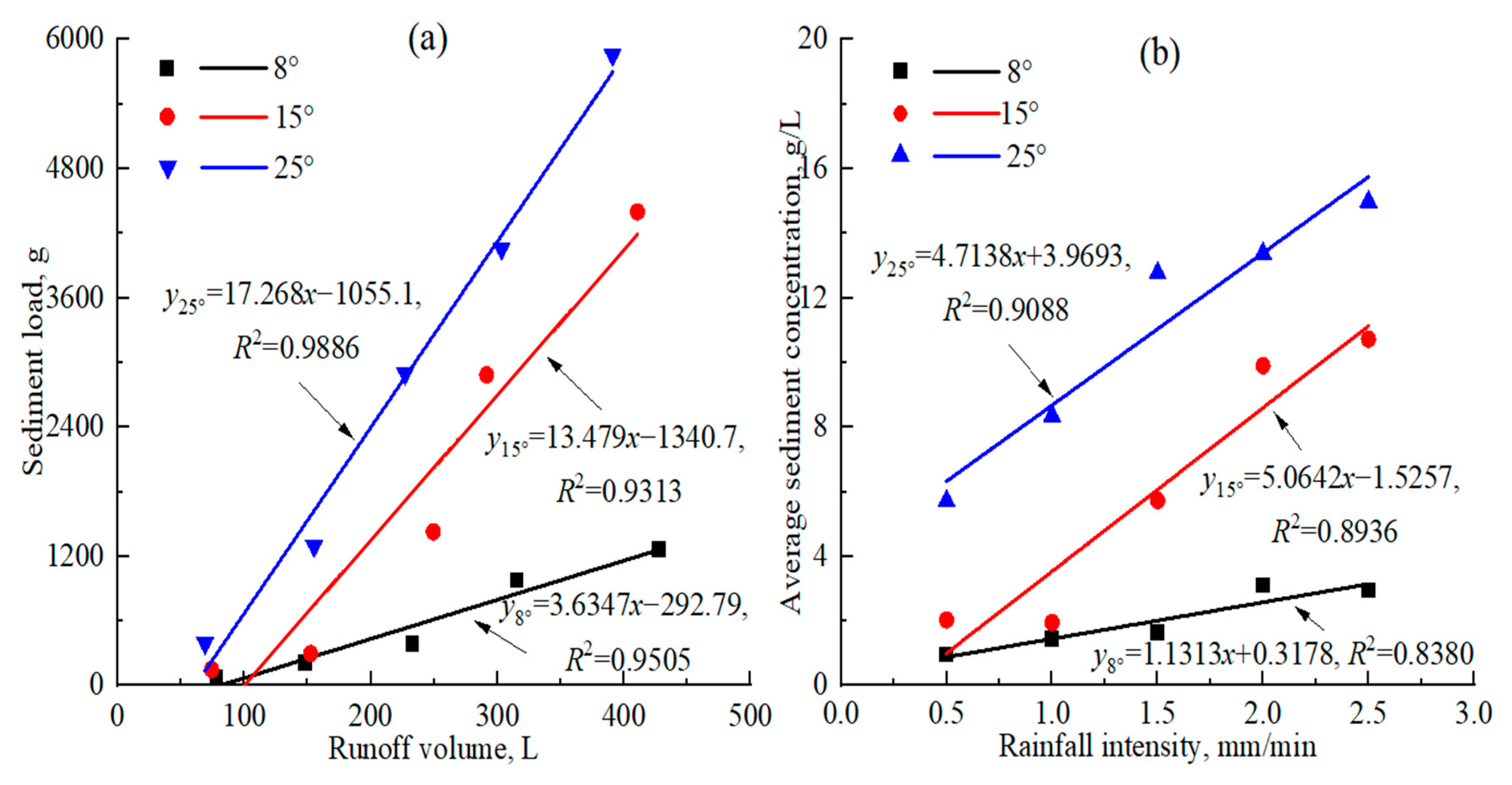
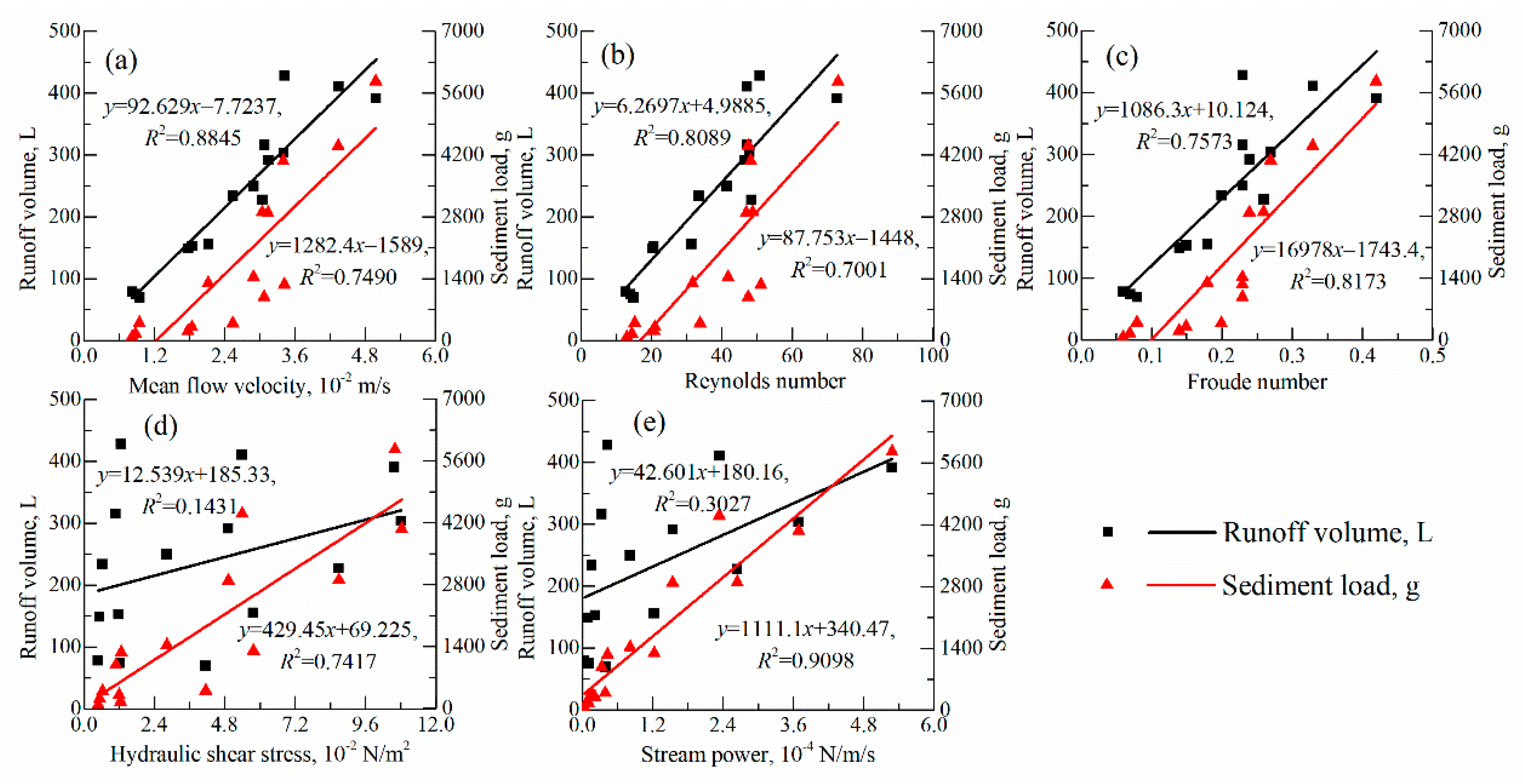
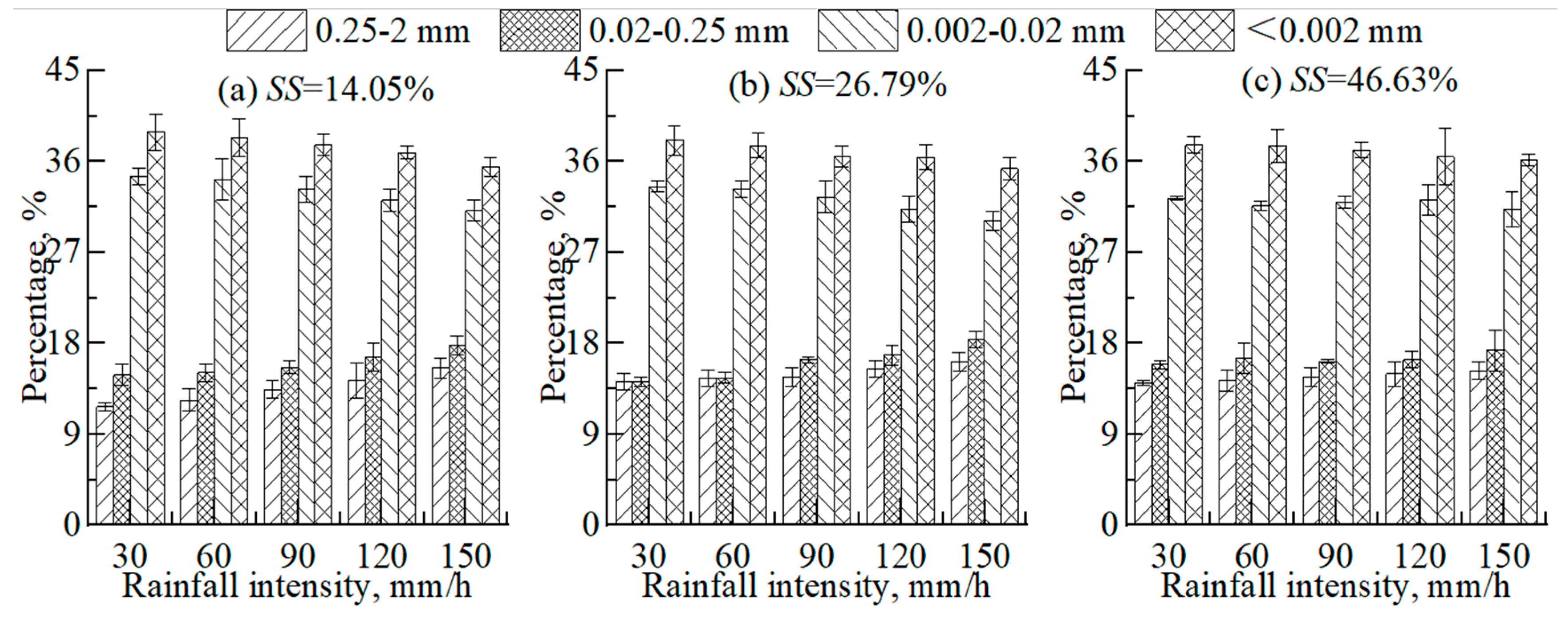
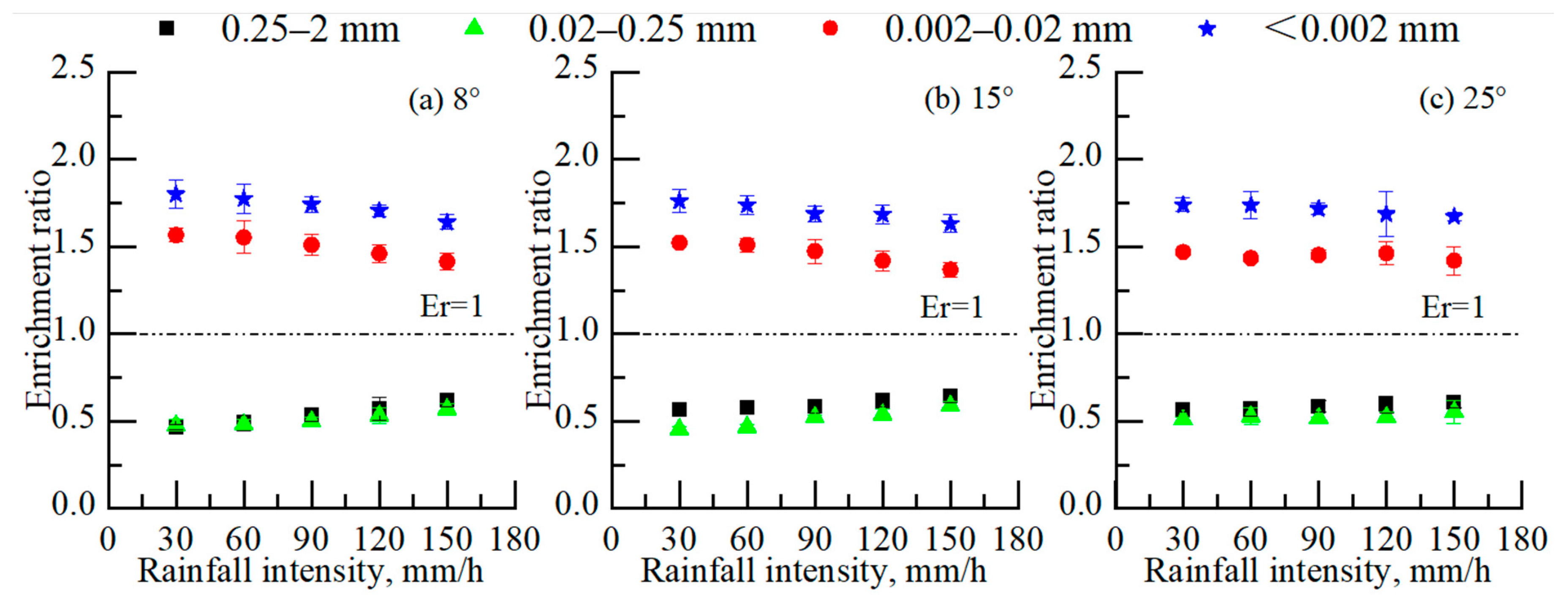
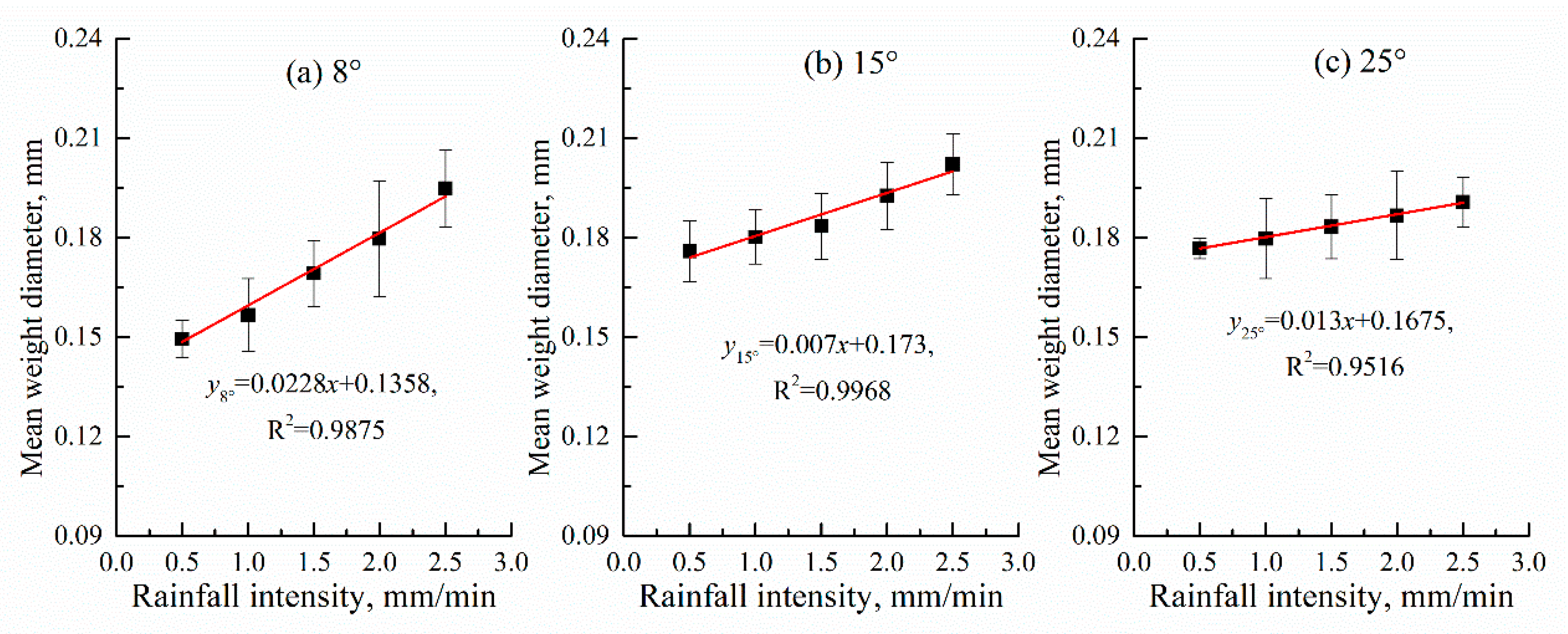
| SS (°) | RI (mm/min) | T0 (min) | Rv (L) | SL (g) | Average Sc (g/L) | I |
|---|---|---|---|---|---|---|
| 8 | 0.5 | 18.55 | 78.30 | 74.50 | 0.95 | 0.88 |
| 1.0 | 4.27 | 148.30 | 212.38 | 1.43 | 0.83 | |
| 1.5 | 2.37 | 233.15 | 384.11 | 1.65 | 0.87 | |
| 2.0 | 1.83 | 315.35 | 975.70 | 3.09 | 0.88 | |
| 2.5 | 1.13 | 427.77 | 1261.40 | 2.95 | 0.96 | |
| 15 | 0.5 | 6.73 | 74.02 | 150.80 | 2.04 | 0.85 |
| 1.0 | 2.36 | 152.25 | 297.49 | 1.95 | 0.88 | |
| 1.5 | 2.00 | 249.15 | 1428.45 | 5.73 | 0.96 | |
| 2.0 | 1.30 | 291.32 | 2886.00 | 9.91 | 0.84 | |
| 2.5 | 0.75 | 410.33 | 4399.23 | 10.72 | 0.94 | |
| 25 | 0.5 | 2.67 | 69.07 | 394.48 | 5.71 | 0.85 |
| 1.0 | 1.58 | 155.23 | 1296.65 | 8.35 | 0.95 | |
| 1.5 | 0.92 | 227.05 | 2899.53 | 12.77 | 0.93 | |
| 2.0 | 0.65 | 303.33 | 4059.55 | 13.38 | 0.93 | |
| 2.5 | 0.45 | 390.98 | 5857.25 | 14.98 | 0.96 |
| SS (°) | RI (mm/min) | V (10−2 m/s) | h (mm) | Re | Fr | τ (10−2 N/m2) | w (10−4 N/m/s) |
|---|---|---|---|---|---|---|---|
| 8 | 0.5 | 0.83 ± 0.01 | 1.75 ± 0.02 | 12.70 ± 2.14 | 0.06 ± 0.00 | 0.47 ± 0.01 | 0.04 ± 0.01 |
| 1.0 | 1.78 ± 0.56 | 1.54 ± 0.49 | 20.44 ± 2.07 | 0.14 ± 0.07 | 0.52 ± 0.16 | 0.09 ± 0.01 | |
| 1.5 | 2.55 ± 0.48 | 1.69 ± 0.36 | 33.52 ± 2.09 | 0.20 ± 0.05 | 0.62 ± 0.13 | 0.16 ± 0.01 | |
| 2.0 | 3.08 ± 0.60 | 1.90 ± 0.37 | 47.25 ± 2.81 | 0.23 ± 0.07 | 1.07 ± 0.21 | 0.33 ± 0.02 | |
| 2.5 | 3.43 ± 0.69 | 2.31 ± 0.55 | 50.80 ± 1.60 | 0.23 ± 0.07 | 1.26 ± 0.30 | 0.43 ± 0.01 | |
| 15 | 0.5 | 0.89 ± 0.09 | 1.54 ± 0.16 | 14.11 ± 0.12 | 0.07 ± 0.01 | 1.23 ± 0.13 | 0.11 ± 0.00 |
| 1.0 | 1.85 ± 0.10 | 1.53 ± 0.09 | 20.69 ± 0.09 | 0.15 ± 0.01 | 1.18 ± 0.07 | 0.22 ± 0.00 | |
| 1.5 | 2.90 ± 0.16 | 1.59 ± 0.09 | 41.48 ± 0.17 | 0.23 ± 0.02 | 2.82 ± 0.15 | 0.82 ± 0.00 | |
| 2.0 | 3.15 ± 0.15 | 1.72 ± 0.08 | 46.66 ± 0.19 | 0.24 ± 0.02 | 4.91 ± 0.24 | 1.55 ± 0.01 | |
| 2.5 | 4.35 ± 0.90 | 1.75 ± 0.35 | 47.22 ± 0.04 | 0.33 ± 0.11 | 5.38 ± 1.07 | 2.34 ± 0.00 | |
| 25 | 0.5 | 0.95 ± 0.05 | 1.35 ± 0.07 | 14.92 ± 0.12 | 0.08 ± 0.01 | 4.14 ± 0.23 | 0.39 ± 0.00 |
| 1.0 | 2.13 ± 0.20 | 1.35 ± 0.12 | 31.35 ± 0.29 | 0.18 ± 0.03 | 5.77 ± 0.52 | 1.23 ± 0.01 | |
| 1.5 | 3.05 ± 0.07 | 1.38 ± 0.03 | 48.52 ± 0.49 | 0.26 ± 0.01 | 8.69 ± 0.20 | 2.65 ± 0.03 | |
| 2.0 | 3.41 ± 0.39 | 1.65 ± 0.20 | 47.95 ± 0.22 | 0.27 ± 0.04 | 10.83 ± 1.30 | 3.69 ± 0.02 | |
| 2.5 | 4.99 ± 0.47 | 1.45 ± 0.14 | 72.76 ± 0.12 | 0.42 ± 0.06 | 10.59 ± 1.04 | 5.29 ± 0.01 |
| Er1 | Er2 | Er3 | Er4 | MWD | T0 | Sc | I | |
|---|---|---|---|---|---|---|---|---|
| RI | 0.726 ** | 0.861 ** | −0.769 ** | −0.904 ** | 0.754 ** | −0.597 * | 0.542 * | 0.575 * |
| SS | 0.384 | 0.172 | −0.395 | −0.170 | 0.374 | −0.395 | −0.768 ** | 0.341 |
| V | 0.720 ** | 0.833 ** | −0.773 ** | −0.860 ** | 0.746 ** | −0.567 * | 0.696 ** | 0.557 * |
| h | 0.156 | 0.380 | −0.166 | −0.415 | 0.180 | −0.464 | −0.317 | 0.385 |
| Re | 0.686 ** | 0.795 ** | −0.744 ** | −0.812 ** | 0.711 ** | −0.520 * | 0.718 ** | 0.478 |
| Fr | 0.687 ** | 0.782 ** | −0.745 ** | −0.798 ** | 0.711 ** | −0.527 * | 0.761 ** | 0.513 |
| τ | 0.514 | 0.461 | −0.562 * | −0.451 | 0.520 * | −0.016 | 0.970 ** | −0.064 |
| w | 0.523 * | 0.523 * | −0.563 * | −0.531 * | 0.534 * | −0.224 | 0.932 ** | 0.162 |
Publisher’s Note: MDPI stays neutral with regard to jurisdictional claims in published maps and institutional affiliations. |
© 2021 by the authors. Licensee MDPI, Basel, Switzerland. This article is an open access article distributed under the terms and conditions of the Creative Commons Attribution (CC BY) license (https://creativecommons.org/licenses/by/4.0/).
Share and Cite
Sun, T.; Deng, L.; Fei, K.; Fan, X.; Zhang, L.; Ni, L.; Sun, R. Runoff Characteristics and Soil Loss Mechanism in the Weathered Granite Area under Simulated Rainfall. Water 2021, 13, 3453. https://doi.org/10.3390/w13233453
Sun T, Deng L, Fei K, Fan X, Zhang L, Ni L, Sun R. Runoff Characteristics and Soil Loss Mechanism in the Weathered Granite Area under Simulated Rainfall. Water. 2021; 13(23):3453. https://doi.org/10.3390/w13233453
Chicago/Turabian StyleSun, Tianyu, Longzhou Deng, Kai Fei, Xiaojuan Fan, Liping Zhang, Liang Ni, and Rui Sun. 2021. "Runoff Characteristics and Soil Loss Mechanism in the Weathered Granite Area under Simulated Rainfall" Water 13, no. 23: 3453. https://doi.org/10.3390/w13233453
APA StyleSun, T., Deng, L., Fei, K., Fan, X., Zhang, L., Ni, L., & Sun, R. (2021). Runoff Characteristics and Soil Loss Mechanism in the Weathered Granite Area under Simulated Rainfall. Water, 13(23), 3453. https://doi.org/10.3390/w13233453






